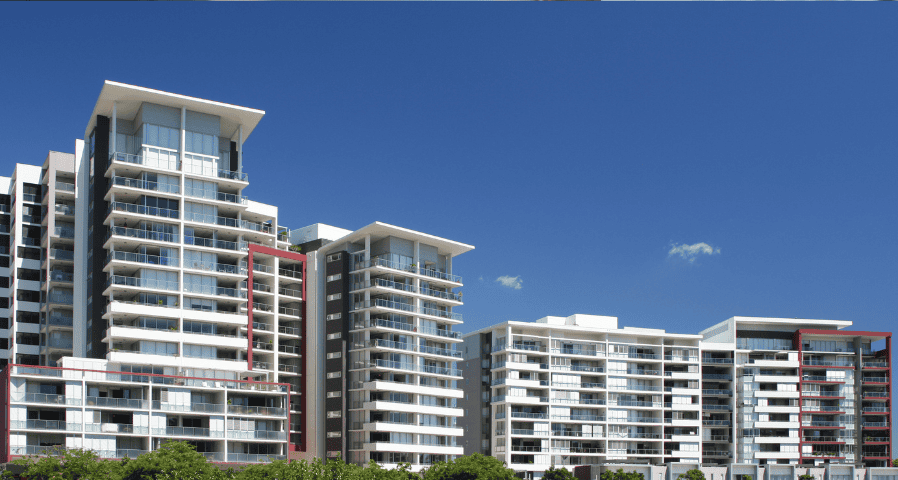An In-depth Look at Bollard and Pathway Lighting
What is Bollard and Pathway Lighting?
Bollard lighting, often called pathway lighting is commonly used for exterior lighting designed for landscaping and pathways. This form of exterior lighting is most typically found in a round or square style post fixture and tends to be between 2ft – 4ft. Due to the bollard and pathway lightings height and desired illumination results, they tend to project light horizontally and/or downward.
Some of the most commonly used bollard and pathway lighting applications utilized today are Metal Halide, High Pressure Sodium, and Mercury Vapor Lamps, which are all forms of High Intensity Discharge (HID) lamps. You might also see a few compact fluorescents in non-LED bollard and pathway lighting. Below are a few visual examples of non-LED bollard and pathway lighting applications.
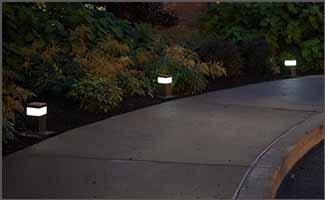
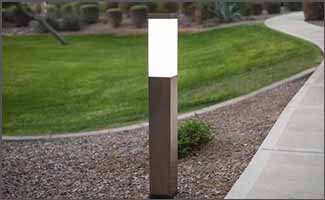
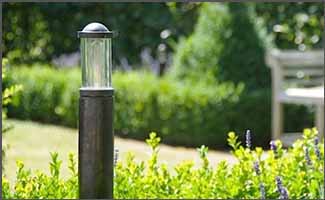
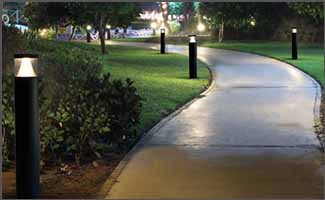
Common Issues in Non-LED Bollard and Pathway Lighting
Metal Halide, High-Pressure Sodium, and Mercury Vapor Lamps are all forms of HID lamps and the most common non-LED canopy lighting. They all share common issues.
Energy Cost
Common HID lamps used in bollard and pathway lighting applications have a typical range of 50 watts to 150 watts, with the higher wattage producing higher light output. There are several factors that play a role in the number of wattages that are utilized, such as quantity, spacing, and height. A 70w or 150w HID fixture can cost between $50 and $100 to operate per lamp/year in electricity costs alone.
Lighting Performance
The performance of HID lamps in bollard and pathway lighting varies by type and age. High-Pressure Sodium lamps offer longer lifespans but emit an orange light with poor color rendering, while Metal Halide lamps start with bright white illumination that quickly fades as lumen output diminishes over time.
Maintenance Costs
Because bollard and pathway lighting operates in high-traffic areas, maintenance can be both frequent and disruptive. Lamp and ballast replacements require labor and coordination, and over time, these costs can add up, often exceeding $400 per fixture within just a few years.
The Benefits of an LED Bollard and Pathway Retrofit
There are valuable benefits to performing an LED retrofit to your organization’s bollard and pathway lighting. Light Emitting Diodes or LED’s generate light utilizing a semiconductor and do not rely on the consumption of a fuel source like an HID lamp. Most LED fixtures utilize multi-point sources which means the fixtures have multiple diodes with individual optics. When compared to the way HID fixtures distribute light, the results in illumination is more evenly distributed across a surface. With this in mind, let’s look at the three most common benefits of an LED Retrofit.
Energy Savings
LED bollard and pathway lighting commonly utilize wattages between 12– 40 watts, which often result in a 40%-85% reduction in energy consumption. This could mean savings of up to $100 per fixture, per year in electricity costs. For more on an LED’s energy savings, check out the section on Energy Savings on our LED Education Page.
Lighting Performance
As a result of an LED fixtures multi-point design, you will see a bright evenly distributed light pattern perfect for illuminating areas frequented by pedestrians. The illumination across a given area will vary less and will eliminate the common bright spot produced by HID fixtures. In addition to your evenly displaced illumination, LED’s come in a variety of color temperatures providing a range of options in increasing the visual perception of brightness. For more on an LED’s lighting performance, check out the section on Lighting Performance on our LED Education Page.
Maintenance Savings
Due to the way LED’s generate light their functional lifespan is much longer. An LED’s generated light output will degrade very slowly over time, and as a result, their functional lifespan can often exceed 100,000 hours. The LED’s lifespan drastically reduces the costs associated with maintaining your bollard and pathway lighting and could result in over $300 in maintenance saving for a single fixture over the course of 3 years. For more on an LED’s lifespan, check out our blog, Understanding LED Lifespan.
More LED Canopy Lighting Resources to Review
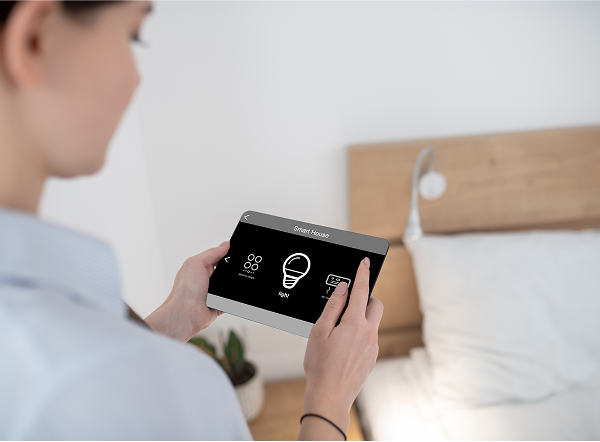
LED Retrofit Education
When narrowing down the best solution for your organization, you will find it to be a challenging endeavor. Because of the thousands of lighting options available in the LED Industry, not all of them offer the same results. With this in mind, we have created an in-depth look at LED retrofits that covers things like;
- What is a turn-key commercial LED retrofit?
- Examples of commercial LED retrofit goals.
- LED lighting Performance
- Commercial applications
- LED energy savings
- LED maintenance Savings
- And so much more!

Understanding CRI, CCT, and Foot Candles in LED Lighting
LED’s are taking the lighting landscape by storm, with a longer lifespan and drastically lower energy expenses, it seems like everyone is considering an LED retrofit. However, one important thing to know is that not all LED lights are created equal. There are a few key metrics that you want to keep your eye on to ensure that you’re getting high-quality LED’s.
In this article, we will look at color rendering index (CRI), correlated color temperature (CCT), and finally foot candle (FC) readings.
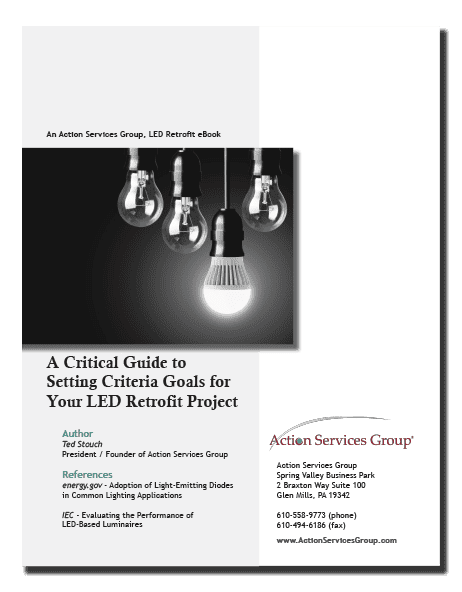
A Critical Guide to Setting Criteria Goals for your LED Project
Narrowing down the best LED solution for your organization can be a challenge. The LED Industry has thousands of lighting options, and not all of them offer the same results. Without knowing product specifics, you might select an LED lamp that provides optimal performance but does nothing for energy efficacy. That is why prioritizing your LED goals should be your first step in any LED Retrofit project.
In this e-book, you’ll find the three criteria goals for any LED project as well as examples of performance, maintenance, and energy saving product selections.
Determining Next Steps in an LED Canopy Lighting Retrofit
You have weighed the pros and cons of contacting a canopy lighting company to retrofit your canopy lighting to LED, and the LED is the clear winner. So, now the big question is, what are the next steps in the process? We have a few considerations for you to review.
Consider partnering with a commercial lighting service provider that can supply a regional, national, and multi-unit LED lighting and electrical project management program. Review these items when vetting a national LED lighting, electrical, and signage service provider.
Interested in Learning More About an LED Bollard and Pathway Retrofit?
The first step in any LED bollard and pathway lighting project should be to contact a lighting and electrical solutions provider or lighting and electrical project management company that is manufacturer and product neutral. With neutrality comes a higher focus on your needs as opposed to the desire or limitation of selling a specific product.
A LED Retrofit provider should ask you about your project.
- What are your desired results?
- Are you looking at budget or project completion constraints?
- Do you have an energy reduction target?
- Are there lighting performance specifics needed to be taken into consideration?
At Action Services Group, our business model is designed to offer you the maximum ROI while taking your lighting performance, maintenance cost, and energy efficiency into consideration. No solution or product is ever a one size fits all, and we understand the need to customize solutions to meet the organization.


